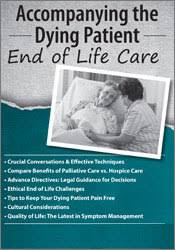Available for Pre-Order. This product will be available within a few days.
Fran Hoh – Accompanying the Dying Patient
Outline:
The Patient at End of Life
Palliative care vs. hospice care
Barriers to providing quality care at the end of life
Research that addresses death and dying
Family Communication at End of Life
Specific challenges addressed
Assessing goals of care
Communication strategies
Interdisciplinary approach
POLST/Advance directive documents
Examples of crucial conversations
Providing Holistic Care at End of Life
Cultural considerations
Grief and loss
Extent of symptoms
Impact on family
Type of disease and prior treatment success or failure
Legal/Ethical Issues
Symptom Management at End of Life
Pain
Dyspnea
Anorexia
Fatigue
Constipation
Nausea/Vomiting
Depression
Anxiety
Patient Outcomes
HCAHPS
Press Ganey
Nursing interventions that impact satisfaction scores
Performance improvement strategies
The Joint Commission Standards
Using MDS in long term care to capture pain management
Would you like to receive Fran Hoh – Accompanying the Dying Patient ?
Description:
Crucial Conversations & Effective Techniques
Compare Benefits of Palliative Care vs. Hospice Care
Advance Directives: Legal Guidance for Decisions
Ethical End of Life Challenges
Tips to Keep Your Dying Patient Pain Free
Cultural Considerations
Quality of Life: The Latest in Symptom Management
There is a renewed focus in health care today on comfort care at the end of life. Research studies reveal that health professionals need to know more about the needs of dying persons regardless of setting: hospital, skilled nursing facility, home care or hospice.
This important topic is seldom taught in medical or nursing school, yet the death rate on our planet is 100%! How, then, is the most supportive end of life care learned today? The answer is through the knowledge and experiences shared by those who have been at the bedsides of dying patients. Your experienced clinician for this educational event, Fran Hoh, PhD, APN, CS, ACHPN, has mentored and educated many patients, family members and healthcare colleagues. She will provide you with concrete strategies to identify patients for whom aggressive therapy is not appropriate, tips to have conversations that address realistic and anticipated goals for care, and the latest when it comes to managing symptoms effectively, specifically pain.
Each end of life patient trusted to your care deserves your compassionate commitment to accompany them well on the final journey of their life.








